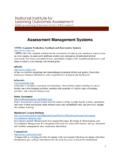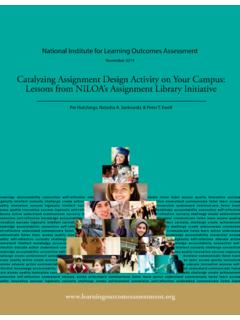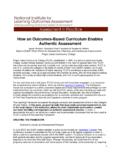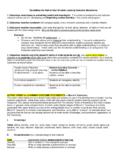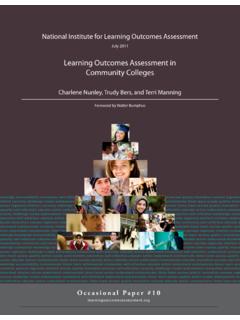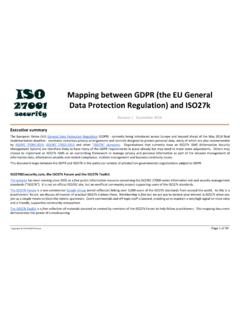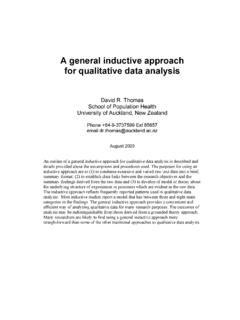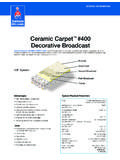Transcription of Assessing General Education: Identifying …
1 1 Assessing General education : Identifying Outcomes, data analysis , and Improvements Molly Beauchman, District Assessment Director, Mathematics Faculty Suzanne Waldenberger, General education Coordinator, Humanities Faculty Yavapai College Identifying General education OUTCOMES Like many colleges, Yavapai College received a wake-up call from its accreditor in 2010: Start producing clear, consistent and relevant assessment data or face a series of escalating consequences. With a history of starts and stops, half-completed projects that went nowhere, and a faculty skeptical about any new initiative, we started from the very beginning in designing a process for Assessing our General education program. Before assessment could begin, we had to identify our General education goals and outcomes. The college had a set of vague statements best described as aspirational: to prepare our students for life in the 21st century, to promote connections between scholastic, personal, professional and civic spheres, and to provide opportunities for personal growth and development.
2 Relying heavily on the AAC&U VALUE rubrics and the LEAP project, these statements were reduced to more concrete (and assessable) concepts. Civic Engagement. Digital Literacy. Oral Communication. A survey was then sent out to all faculty teaching in a degree program, asking them to rank the relevance of ten different General education skills to what students are learning in their program. Unsurprisingly, most faculty indicated that all these skills were relevant and important to their students' success, and all ten were consequently folded into what would become called the GECCO, Yavapai College's General education Core Curriculum Outcomes. (No, our college's mascot is not a gecko, sadly.) The GECCO was added to, and overlaps, a statewide set of transfer categories shared by all institutions of higher education in Arizona, the Arizona General education Curriculum (AGEC.)
3 General education concepts in hand, the coordinator of the General education program held a series of meetings, one for each new GECCO category. In addition, we took the opportunity to simultaneously review the outcomes established for the AGEC categories. An invitation was sent Assessment in Practice 2 to all faculty to participate in the development/revision of assessable outcomes for each category. The refining of these outcomes continued during subsequent convocation weeks, department meetings and assessment workshops until consensus was reached on each. It took one academic year to finalize outcomes for all categories. As the outcomes for each category were finalized, work turned to creating a rubric that could be used as an aid to assessment. Again the AAC&U VALUE rubrics proved invaluable. As part of the assessment process, the year before data collection was dedicated to finalizing the rubrics for the following year s GECCO and AGEC categories.
4 It was ultimately a 6-year process to develop outcomes for all ten GECCO and four additional AGEC categories and their associated rubrics. General education ASSESSMENT PROCESS The fourteen categories are assessed on a staggered schedule in a five-year cycle. The GECCO categories are assessed in two places; General education courses and Associate of Applied Science (AAS) program courses selected by their faculty and identified on each program s curriculum map. For each General education category, data are collected from a random sample of ten students selected from every relevant course offered over a period of two years. This allows us to evaluate both students' achievements of the General education outcomes in the classes designed to meet those outcomes, as well as determine how well students are applying General education skills in the core classes for their various majors.
5 3 By using a shared rubric across a wide variety of courses, Yavapai College allowed faculty maximum flexibility in how they assess each outcome while establishing a shared set of expectations that allows for cross-curriculum analysis . Assessment is embedded in class assignments. In some cases, departments chose to establish shared assessment assignments. In others, faculty chose one or more assignments that best allowed students the opportunity to demonstrate proficiency in the outcome being assessed. In all cases, results were reported on a four-point scale aligned with the rubric structure; Advanced (4), Proficient (3), Developing (2) and Limited (1). Two other reporting options were included, Vanished (intended for students who are still on the roster, but who did not complete the assignment/activity used to assess the outcome ) and Not Applicable1 (for AAS faculty to select if their course does not meet a specific outcome in the GECCO category).
6 ASSESSMENT DAY In order to help support the assessment process and provide a way for faculty to work together, Yavapai instituted an assessment day held every year in September (2017 is the fourth year). Assessment Day is supported by the administration and facilitated by faculty members of the Student Learning Outcomes, General education and Curriculum Committees. The morning sessions focus on General education assessment and the afternoon sessions focus on program and department assessment. Part of this work is analyzing data that provides information about attainment of outcomes in the General education and degree course. The process has allowed all faculty to participate in determining what is valued as an institution and has provided time for all faculty to communicate and design assessment around a shared goal: student success. General education data REPORT DESCRIPTION data collected through Banner are returned to the Assessment Director in the form of an EXCEL spreadsheet that contains raw data totals and individual course totals for the two-year period.
7 Graphical displays of students attainment of each outcome that are appropriate for the GECCO category are created and reports are distributed to faculty during Year 3 of the assessment cycle. Graphical displays include the distribution of rubric scores and the percentage of students who successfully attained the outcome . These are provided at the institution, General education course, and AAS Program course levels. 1 AAS program courses are required to assess at least one outcome from each GECCO category and General education courses must assess all outcomes in the GECCO category. 4 Examples of graphical displays for Quantitative Literacy are included below: All General education and AAS Program courses combined Comparison between all Mathematics courses and all AAS Degree courses 0%10%20%30%40%50%Advanced (4)Proficient (3)Developing (2)Limited (1)VanishedN/AQuantitative Literacy Rubric Results (F2014-S2016)All Gen Ed and AAS Program Courses(66 instructors, 289 courses, 2646 students)LO #1LO #2LO #3LO #477%72%71%66%0%20%40%60%80%100%LO #1LO #2LO #3LO #4 Quantitative Literacy Results (F2014-S2016)All Gen Ed and AAS Program CoursesSuccessful: 3 or 4 (not including V or N/A) #1LO #2LO #3LO #4 Quantitative Literacy: All Math Courses Percent Successful (3 or 4) not including V or #1LO #2LO #3LO #4 Quantitative Literacy.
8 All AAS Degree Courses Percent Successful (3 or 4) not including V or NA 5 In some cases, a comparison between a specific General education course(s) and AAS Program course(s) is included. For example, Technical Mathematics is required for the majority of Career and Technical education programs. Additional displays are created at the department level for their analysis if a particular department is associated with a General education category, such as Quantitative Literacy and the mathematics department. 76%60%54%61%74%84%77%84%0%10%20%30%40%50 %60%70%80%90%100%LO #1LO #2LO #3LO #4 Quantitative Literacy ResultsSuccessful: 3 or 4 (not including V or N/A)Technical MathAAS 100 MAT 142 MAT 152 MAT 156/157 MAT 167 MAT 172/212 MAT 187 MAT 220 MAT 230/241/262 Quantitative Literacy ResultsSuccessful: 3 or 4 (not including V or N/A)LO#1: Use appropriate mathematical language and operations.
9 6 analysis OF data During Year 3 in the assessment cycle, data reports are shared with all faculty, Deans, Department Chairs and Program Directors during Assessment Day so they can discuss results and actions based on the results. When analyzing the data report, we ask that faculty consider attainment of the outcomes for students in all courses, AAS Program courses, and General education courses when answering the following questions: How well are students attaining the desired outcomes? What benchmark for success is reasonable for your data ? What percentage of students successful (scoring 3 or 4) would you consider acceptable? Are there any trends in student attainment of the outcomes? Describe in terms of the benchmarks how well students are doing. Are there any outcomes or content areas where students score very high or very low? What are possible reasons why students score very high or low on a particular outcome ?
10 Discuss any changes in curriculum or instruction that may help students learn the desired information. If the possible reason is the assessment process itself, review and make improvements to the process. Does the assessment process need to be revised? Do the outcomes clearly state what you would like students to be able to do? Does the rubric clearly define levels of attainment? Does the course assignment or process used to assess the outcome need to be revised? How will you communicate the outcomes and process to all faculty and students between now and the next collection cycle? What actions or resources are needed to help students attain the outcome ? What adjustments or improvements are needed to improve curriculum or instruction? What adjustments or improvements are needed to the assessment process so information is valid and reliable? What resources are needed?
